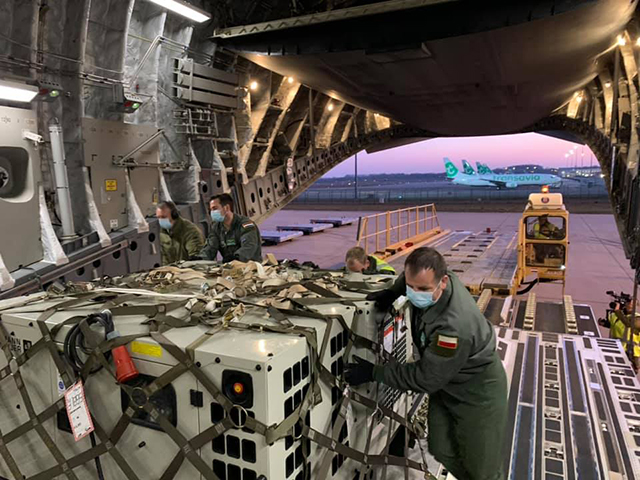The Strategic Airlift Capability’s Heavy Airlift Wing sprung into action early in the COVID-19 pandemic to deliver desperately needed protective equipment within weeks in what became a “defining moment” for the program, the HAW’s commander said.
The 12-year-old SAC, which includes three Globemaster IIIs jointly purchased and flown by the U.S. and 11 other nations out of Papa Air Base, Hungary, is tasked with delivering materiel, especially humanitarian aid, for its member nations. The wing’s expertise in international operations and established diplomatic connections made it uniquely suited to provide quick and effective airlift at a time when its member nations needed it most, HAW commander USAF Col. James Sparrow said during a virtual SMi Group conference on international airlift on Dec. 2.
“This is where we came into the picture for our member nations, we have the capacity and capability to push through logistics and diplomatic processes and in hours versus days we can get our aircraft into the air very quickly,” Sparrow said.
An emergency response mission for humanitarian aid takes precedence over all others within the wing, so when the requests came, HAW’s C-17s quickly took to the air.
The first mission took place March 25, when the wing tasked a C-17 to airlift a load of personal protective equipment from South Korea to member nation Romania. The wing flew three missions to Romania, delivering 145 tons of equipment. Sparrow, who flew part of the mission, said the skies and runways at the time were empty because the world was slowing to a stop as lockdowns began.
“It was kind of eerie, because there was no one flying,” Sparrow said. “I mean, the airways were pretty much quiet. … It was quite deafening, the silence.”
On April 5, the Netherlands, another member nation, requested support to airlift mobile intensive care units to the Caribbean island of St. Maarten.
And on April 17, a HAW C-17 flew 20 tons of PPE and test kits from Beijing to Bulgaria. This mission marked the first time the consortium had flown into China, and required overcoming diplomatic and logistical challenges to accomplish it. The wing flew in additional personnel and their own pallets, and loaded boxes of equipment on the ground in China before returning.
The wing also helped its host nation on April 24, flying 45 tons of medical equipment from Malaysia to Budapest.
Sparrow said the wing’s three C-17s, which it has owned since its inception, are naturally facing maintenance issues as they age. That, coupled with increased taskings by member nations, has pretty much maxed out the wing. Although the wing is not currently considering adding airframes, more planes would be needed in the future if it were to expand its operations. If any new country were to join the consortium, they would need to work bilaterally with an existing nation to get a share of allotted flight hours, Sparrow said.
Since Boeing has ended the C-17 production line, this would require the USAF to sell the SAC second-hand C-17s, or other aircraft such as C-130s. Hungary recently purchased two Embraer KC-390 refueling and transport aircraft. While the country has not announced if they will be based at Papa Air Base or if they could be used in cooperation with the HAW, it is a “fascinating” idea, Sparrow said.
“I have not heard plans to actually base the aircraft here at Papa, to use them in cooperation with us, but that makes sense to me. I think, longer term, I would like to see that.”
